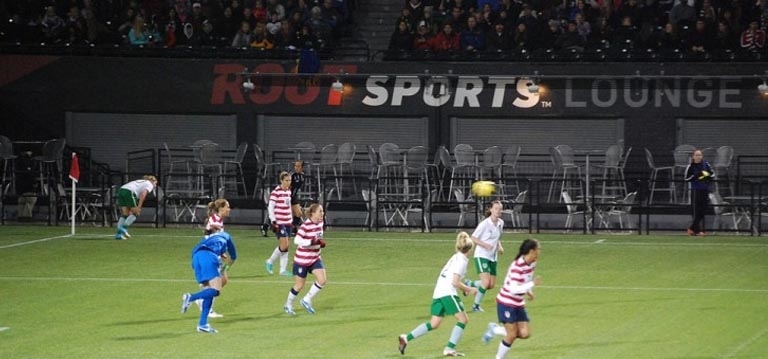Women’s Soccer Gets A Red Card: Discussing The Recent Lawsuit Filed by U.S. Soccer

Photo credit: https://www.flickr.com/photos/suzieblue/
February 23, 2016
The U.S. Women’s National Soccer Team is on the road to the Olympic Games in Rio de Janeiro. In the next few weeks, the team will compete in a tournament with hopes of reaching the CONCACAF Woman’s Olympic Qualifying Championship – the gateway to Brazil and another step toward achieving an Olympic gold medal. However, while individual team members focus on strategies on the field, the Women’s National Soccer Team and the union that represents it is unfortunately entangled in far less sunny off-field issues.[1] U.S. Soccer, the national governing body for soccer, is suing the world champion team.[2]
The Lawsuit
U.S. Soccer recently filed a lawsuit against the Women’s National Soccer Team Players Association to enforce a collective bargaining agreement.[3] The former, expired collective bargaining agreement remains in effect only because of a memorandum of understanding.[4] The collective bargaining agreement expired in 2012, and the memorandum of understanding was signed in 2013.[5] The memorandum of understanding “included a number of changes and amendments to player rights on matters such as salaries and the launch of the National Women’s Soccer League.”[6] While U.S. Soccer believes that the agreement is binding, however, the Players Association does not.[7] The Players Association wishes to dissolve the memorandum of understanding; however, U.S. Soccer is treating the memorandum of understanding as a collective bargaining agreement, which will not expire until the end of this year.[8]
U.S. Soccer may have filed the lawsuit in reaction to “the union refus[ing] to agree in writing that it would not take any labor actions this year.”[9] In a statement issued by U.S. Soccer, the organization stated “U.S. Soccer felt it necessary to take this course of action after Richard Nichols . . . notified U.S. Soccer that he does not believe there to be current CBA, a position which would allow the team to take labor actions on and after February 24”[10] U.S. Soccer is asking for declaratory relief stating “the players’ union must abide by a slightly modified version of the agreement.”[11] However, Nichols stated, “‘There were no threats about strikes or work stoppages.’”[12] Instead, Nichols told U.S. Soccer that the memorandum of understanding was not a collective bargaining agreement, and unless a new agreement was developed the memorandum would not bind the players.[13] Furthermore, Nichols stated in an email “the CBA no longer exists, and further, that the MOU is terminable at will.”[14] Nichols believes that U.S. Soccer interpreted the players’ exercising their legal rights as a threat.[15]
The Players Kick Back
In their response to U.S. Soccer’s complaint, the Players Association argues that the U.S. Soccer’s financial statements state that there is no collective bargaining agreement in place.[16] The pertinent part of the statement reads, “[t]he Women’s National Team CBA expired on December 31, 2012. There is currently a signed Memo of Understanding in place while the full details of the new Women’s National Team CBA are being negotiated.”[17] Thus, the players argue that the memorandum of understanding was not meant to be a permanent solution.
The second argument the Players Association makes in its response is that the memorandum of understanding does not have any term limits.[18] While U.S. Soccer believes that the memorandum of understanding “amends the old [collective bargaining agreement], and all unmodified terms (including the no-strike clause) remain intact through December 31, 2016,” there is nothing supporting this conclusion.[19] Therefore, the Players Association believes that it has a right to dissolve the memorandum of understanding because it has no end date.[20] Nicholas stated “if a new [collective bargaining agreement] was not in place within 60 days, the union will terminate the [memorandum of understanding] that extended the expire agreement.”[21]
An additional argument that the Players Association makes in its response is that U.S. Soccer intentionally left out important parts of an email from the Players Association lawyer, Ruth Uselton, and testimony from the Players Association prior executive director, John Langel. The email exchange between Ruth Uselton and U.S. Soccer was not included in the exhibits provided by U.S. Soccer when it filed the lawsuit.[22] In her email, Uselton stated to U.S. Soccer “We will address the specifics when we get to drafting the new [collective bargaining agreement].”[23] In the motion, the Players Association argues “This quote shows that the ‘new [collective bargaining agreement]’ (i) did not exist yet, and (ii) was yet to be drafted, and importantly, that (iii) the parties had not yet negotiated the specifics of the new [collective bargaining agreement’s] terms”[24] Furthermore, U.S. Soccer did not include statements made during John Langel’s deposition involving the men’s national team. In the withheld statement, Langel said, “But we’ve already agreed that the terms [of the prior collective bargaining agreement] don’t control in certain circumstances.”[25] The Women’s National Soccer Team Players Association argues that this statement proves “that the terms of the prior [collective bargaining agreement] were not all agreed to be carried forward in the [memorandum of understanding].”[26]
These pieces of evidence strengthen the Players Association’s argument that the memorandum of understanding can be terminated at any time. However, the court has the ultimate decision. The outcome of the lawsuit can have huge consequences for the women’s team.[27] In fact, if the court rules in favor of the Players Association and the players decide to strike, “US Soccer says they may need to drop out of the Olympics.”[28] The fans can only hope that the two parties come to an agreement so as not to compromise the Olympics in Rio de Janeiro this summer.
* Staff Writer, Jeffrey S. Moorad Sports Law Journal; J.D. Candidate, May 2017, Villanova University Charles Widger School of Law.
[1] See Martin Rogers, U.S. Soccer lawsuit v. players’ union is no-win situation, USA Today (Feb. 4, 2016, 7:14 PM), http://www.usatoday.com/story/sports/soccer/2016/02/04/us-soccer-lawsuit-players-union/79847008/ (“The toughest battle the U.S. women’s soccer team faces in the run-up to the Olympics in Rio de Janeiro this summer might end up being in a courtroom rather than a stadium.”).
[2] See Andrew Das, U.S. Soccer Sues Union Representing the Women’s National Team, N.Y. Times (Feb. 3, 2016), http://www.nytimes.com/2016/02/04/sports/soccer/us-soccer-sues-womens-national-team-in-federal-court.html?ref=soccer (discussing recent lawsuit regarding women’s national team).
[3] See generally Complaint for Anticipatory Breach of Contract and for Declaratory Relief, United States Soccer Federation v. United States Women’s National Soccer Team Players Association, No. 1:16-cv-01923 (N.D. Ill. Filed Feb. 3, 2016); see also Steven Bank, Divided Loyalties: Lawsuits, U.S. Soccer and the NWSL, American Soccer Now (Feb. 10, 2016, 7:00 PM), http://americansoccernow.com/articles/divided-loyalties-lawsuits-u-s-soccer-and-the-nwsl (noting irony that lawsuit was filed on National Girls and Women in Sports Day).
[4] See Sam Borden & Andrew Das, U.S. Soccer Lawsuit Disclosed Players’ Personal Information, N.Y. Times (Feb. 4, 2016), http://www.nytimes.com/2016/02/05/sports/soccer/us-soccer-lawsuit-disclosed-players-personal-information.html?_r=1 (summarizing premise of lawsuit filed by U.S. Soccer). “A Memorandum of Understanding (MOU) is a written agreement between two or more parties that defines the roles and responsibilities of each party with respect to the collaborative efforts of a particular program/project.” See Memorandum of Understanding (MOU), HUD.gov, http://www.hud.gov/offices/pih/programs/hcv/wtw/resources/bs8/mou_guide.pdf (last visited Feb. 19, 2016, 9:07 AM) (explaining memorandums of understanding).
[5] See Borden & Das, supra note 4 (explaining U.S. Soccer’s decision to file lawsuit against Women’s National Team).
[6] Jonathan Tannenwald, U.S. Soccer Federation Sues Women’s National Team Union Over CBA, Philly.com (Feb. 4, 2016, 3:50 P.M.), http://www.philly.com/philly/blogs/thegoalkeeper/US-Soccer-Federation-sues-womens-national-team-over-CBA.html.
[7] See Rogers supra note 1; see also Borden & Das, supra note 4 (“The union’s leadership contends that [the memorandum of understanding] does not [remain in effect] and that it can repudiate the agreement with 60 days’ notice.”)
[8] See Kevin Draper, USWNT Players Association Files Withering Response To U.S. Soccer Lawsuit, Screamer (Feb. 8, 2016, 10:23 PM), http://screamer.deadspin.com/uswnt-players-association-files-withering-response-to-u-1757963962 (discussing women’s team’s response to lawsuit filed by U.S. Soccer).
[9] Borden & Das, supra note 4.
[10] Tannenwald, supra note 6 (quoting February 3 U.S. Soccer statement).
[12] See id. (quoting Nichols on February 3).
[13] See id. (discussing perspectives of U.S. Soccer and Women’s National Team).
[14] Bank, supra note 3 (quoting e-mail from Nichols to U.S. Soccer).
[15] Das, supra note 2 (quoting Nichols statement that “[t]hey interpreted that as a threat”).
[16] See Draper, supra note 8 (quoting specific parts of U.S. Soccer’s financials); see also Kevin McCauley, USWNT Responds to US Soccer Lawsuit, Calling Their Claims ‘Fiction’, SB Nation (Feb. 8. 2016, 5:06 PM), http://www.sbnation.com/soccer/2016/2/8/10940846/uswnt-responds-to-us-soccer-lawsuit-calling-their-claims-fiction (discussing women’s team’s arguments against U.S. Soccer); Andrew Das, Union for U.S. Women’s Soccer Team Files Response in Lawsuit, N.Y Times (Feb. 8, 2016), http://www.nytimes.com/2016/02/09/sports/soccer/union-for-us-womens-soccer-team-files-response-in-lawsuit.html?_r=0 (analyzing union’s response to lawsuit). According to the response filed by the union, the union “charged that U.S. Soccer had filed ‘misleadingly incomplete’ documentation to support its lawsuit.” Das, supra.
[17] Motion for an Expedited Initial Status Conference at 4-5, United States Soccer Federation, Inc. v. United States Women’s National Soccer Team Players Association, No. 1:16-cv-01923 (N.D. Ill. filed Feb. 8, 2016); see also McCauley, supra note 16. U.S. Soccer “can reasonably argue that its financial statements are not written by anyone with a background in labor law,” but this statement weakens their case. McCauley, supra note 16.
[18] See Motion for an Expedited Initial Status Conference, supra note 17, at 4 (discussing lack of terms in memorandum of understanding); see also McCauley, supra note 16 (explaining lack of term in memorandum of understanding); Draper, supra note 8 (“The MOU doesn’t actually say anything about the old CBA remaining valid through 2016.”).
[20] But see Bank, supra note 3 (analyzing terms of agreement). Although the “MOU did not specifically state an end date, . . . it did suggest in less than clear language that it had a term of four years.” Id.
[21] Caitlin Murray, Explained: Why US Soccer is Suing Its Own World Cup Winners, The Guardian (U.K.) (Feb, 4. 2106, 7:58 AM), http://www.theguardian.com/football/blog/2016/feb/04/explained-why-us-soccer-is-suing-its-own-world-cup-winners (citing December 23 letter from Nichols).
[22] See Draper, supra note 8. (discussing lack of email and why U.S. Soccer left it out).
[23] Motion for an Expedited Initial Status Conference, supra note 17, at 5; see also Draper, supranote 8.
[24] Motion for an Expedited Initial Status Conference, supra note 17, at 5.
[25] Id. at 6; see also Draper, supra note 8.
[26] Motion for an Expedited Initial Status Conference, supra note 17, at 6.
[27] See Murray, supra note 21 (discussing possible outcomes of lawsuit); see also Das, supra note 16 (stating that event hosted by U.S. Soccer in early march “could be imperiled if the players threaten a job action as part of their labor dispute”).

